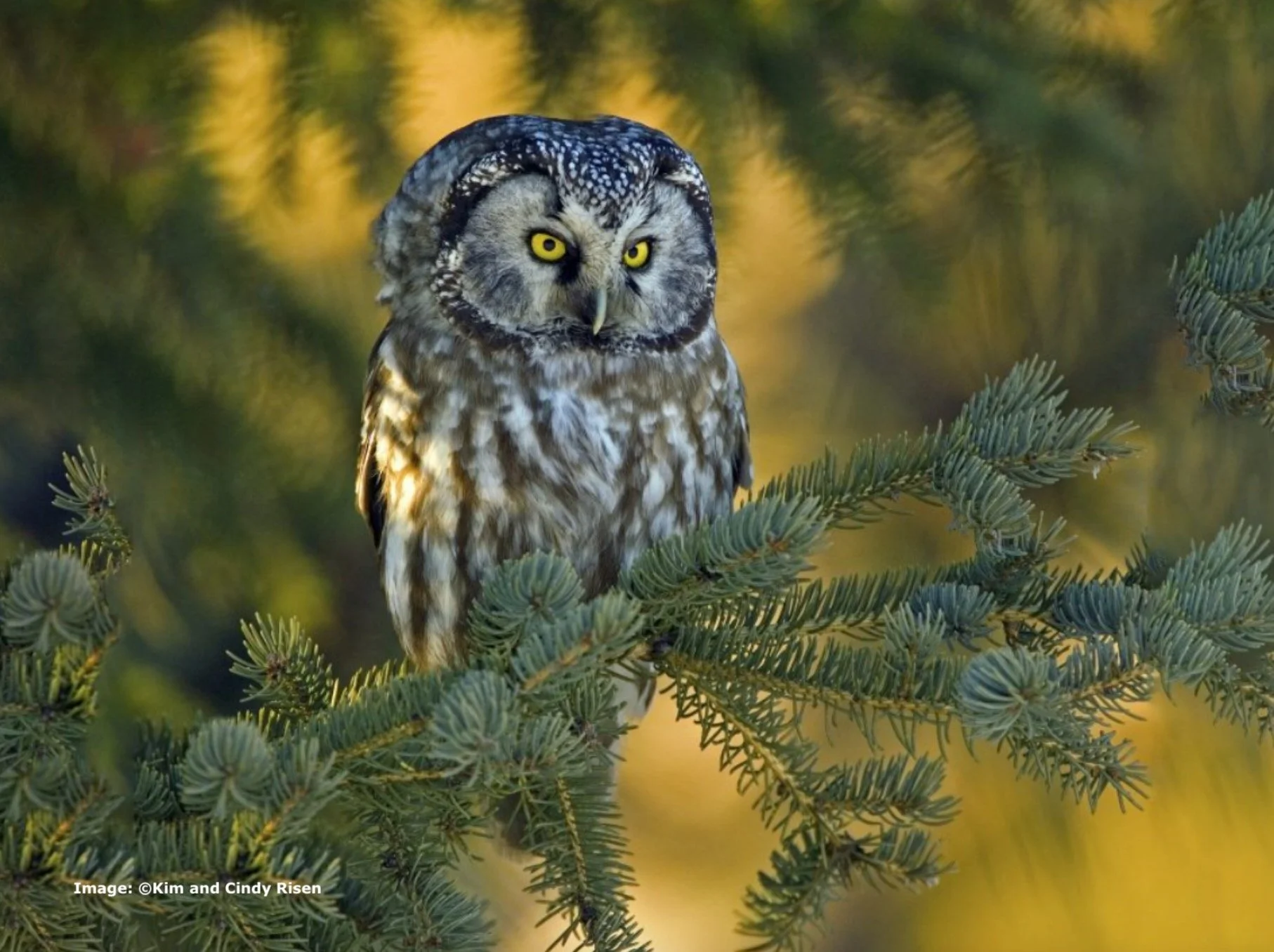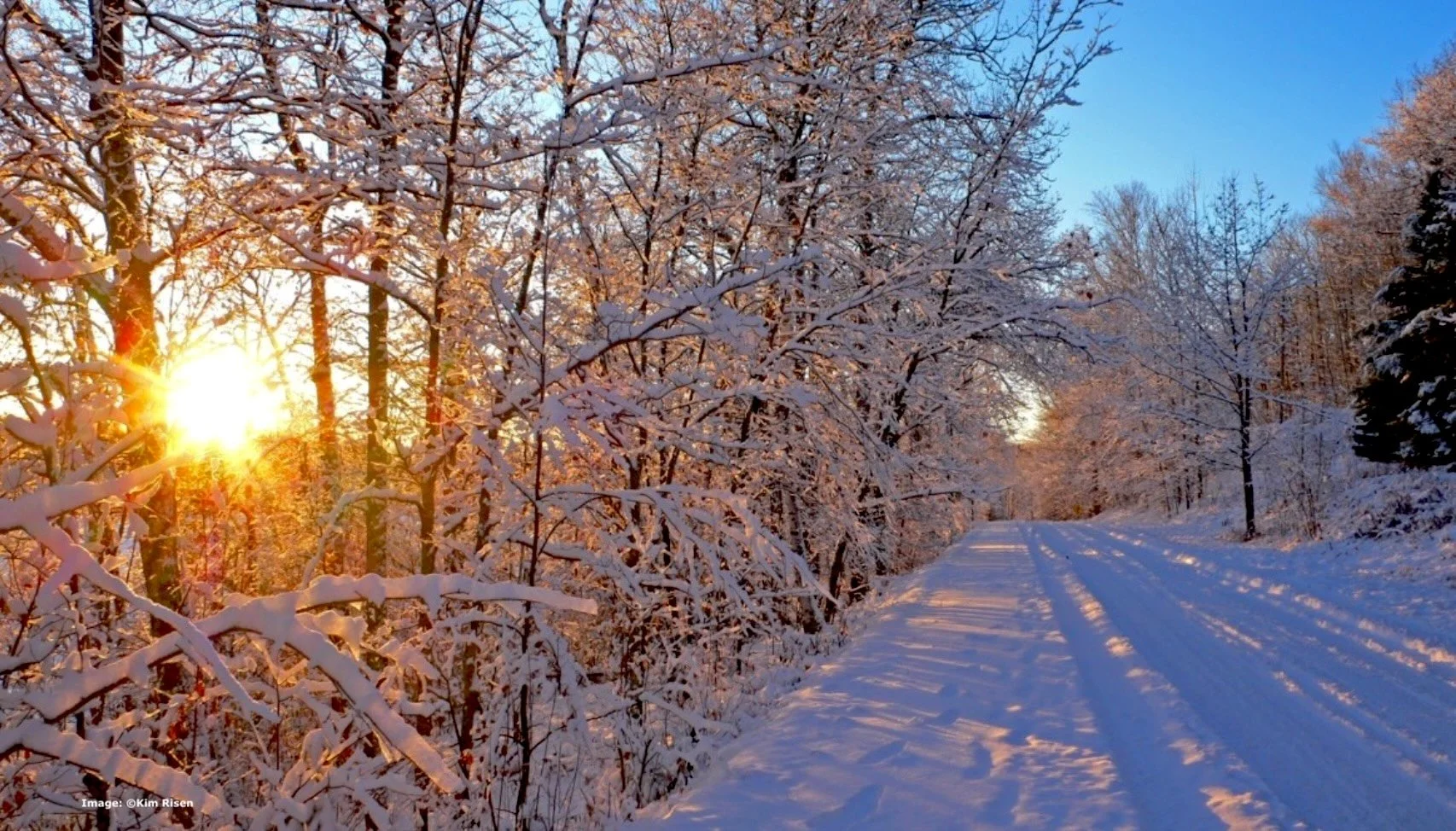Winter Owls, Hawks and Others in Minnesota, Rarities and Residents!
Minnesota’s Rarities and Residents! Winter Owls, Hawks, and More
To Benefit Project SNOWstorm
6 Days - 5 Nights
Discover why Minnesota’s Sax-Zim Bog and surrounding boreal forests are a bird watcher and photographer’s paradise!
And celebrate the New Year with Great Grey and Boreal owls, spruce grouse, Bohemian waxwings, White-winged and Red Crossbills,
and maybe even some Snowy Owls!.
January 14 - 19, 2026
$4514.00 - double occupancy, ex-flight
Single supplement $375.00
Questions? Contact us.
10% of your ticket cost is a tax-deductible donation to Project SNOWstorm in YOUR name
Your acknowledgement and donation receipt come to you from Project SNOWstorm
Limited to 6 Guests
Why This Tour is Special
Great Grey Owl at twilight. Image: ©Kim and Cindy Risen
★ Owl Irruption in 2025 - will we be lucky in 2026? Fingers crossed. In the winter of 2025, the Duluth area and northern Minnesota saw a greater-than-usual influx of Boreal, Great Gray, and Snowy Owls!
★ Discover Winter Bird Paradise! The incomparable Sax-Zim bog is a paradise for wintering Arctic and sub-Arctic breeders. And don’t forget Minnesota’s boreal forests.
★ Get the Shot! Your guide is a professional birder and photographer.
Glittering winter scenery provides an excellent (photographic) backdrop for Great Gray and Northern Hawk Owls hunting from spruce-top perches, Sharp-tailed and Ruffed Grouse stripping Birch buds by morning’s glowing light, legions of Snow Buntings wheeling in tight formation, flocks of colorful Pine and Evening Grosbeaks, frenzied Common and Hoary Redpolls darting among Alder thickets and Tamarack bogs occupied by Black-backed and American Three-toed Woodpeckers and so much more.
★ Not all of northern Minnesota’s winter residents have wings. Snoeshoe hare, Beaver, Porcupine, two weasel species (the Long-tailed and Short-tailed), Mink, Fisher, Moose, and even Grey Wolf live in these remote forests. We may even spot a Pine Martin, Lynx, or Bobcat.
★ Explore it All with New Friends. It takes a special person to venture out in the cold and snow for birds - get to know your like minds over warm dinners and stories at the end of a brisk day.
★ Help Snowy Owl Research! We cannot save what we do not understand. Our trip supports Project SNOWstorm, which is run by volunteers and funded entirely with donations. This is an unforgettable journey that does (measurable) good!
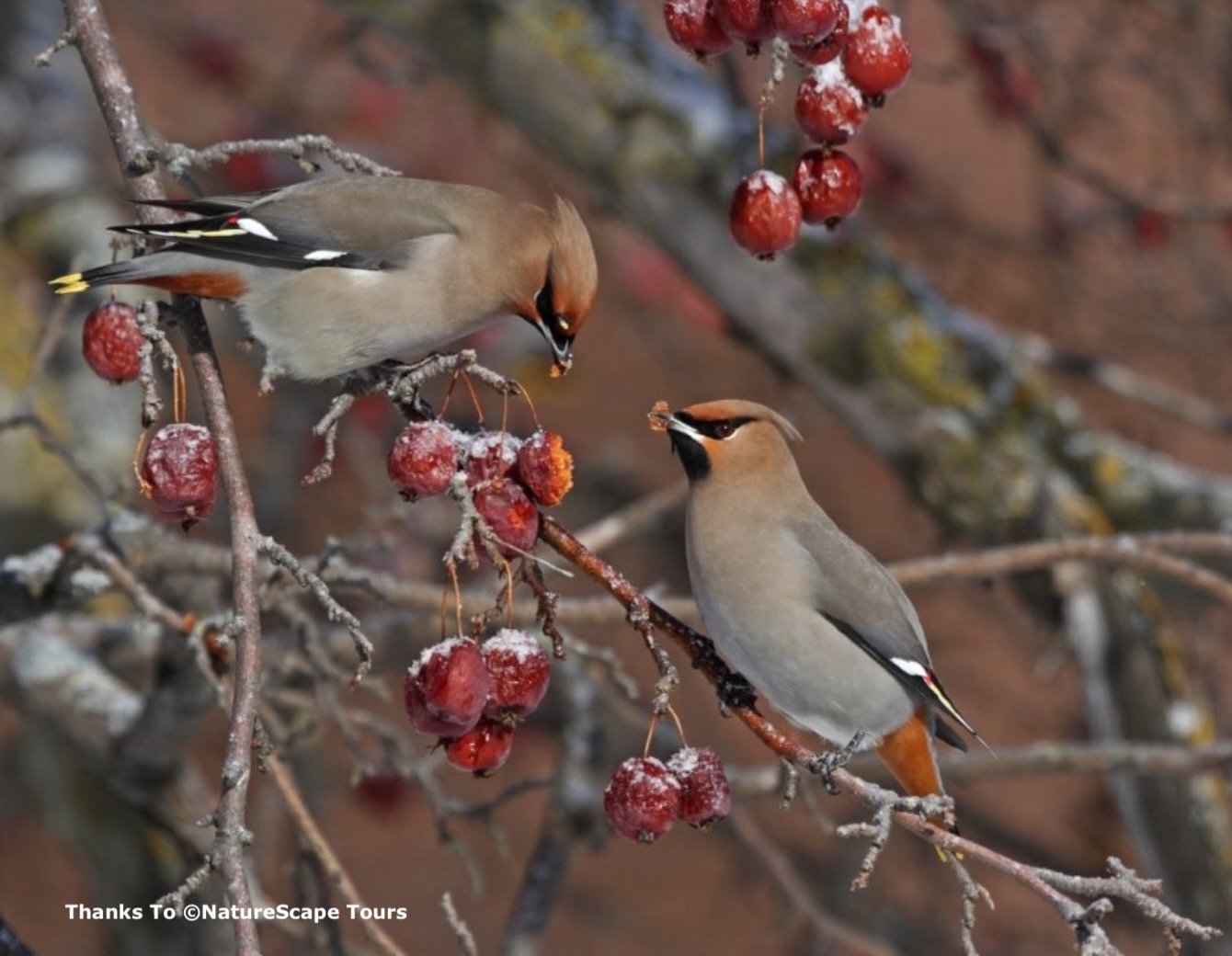
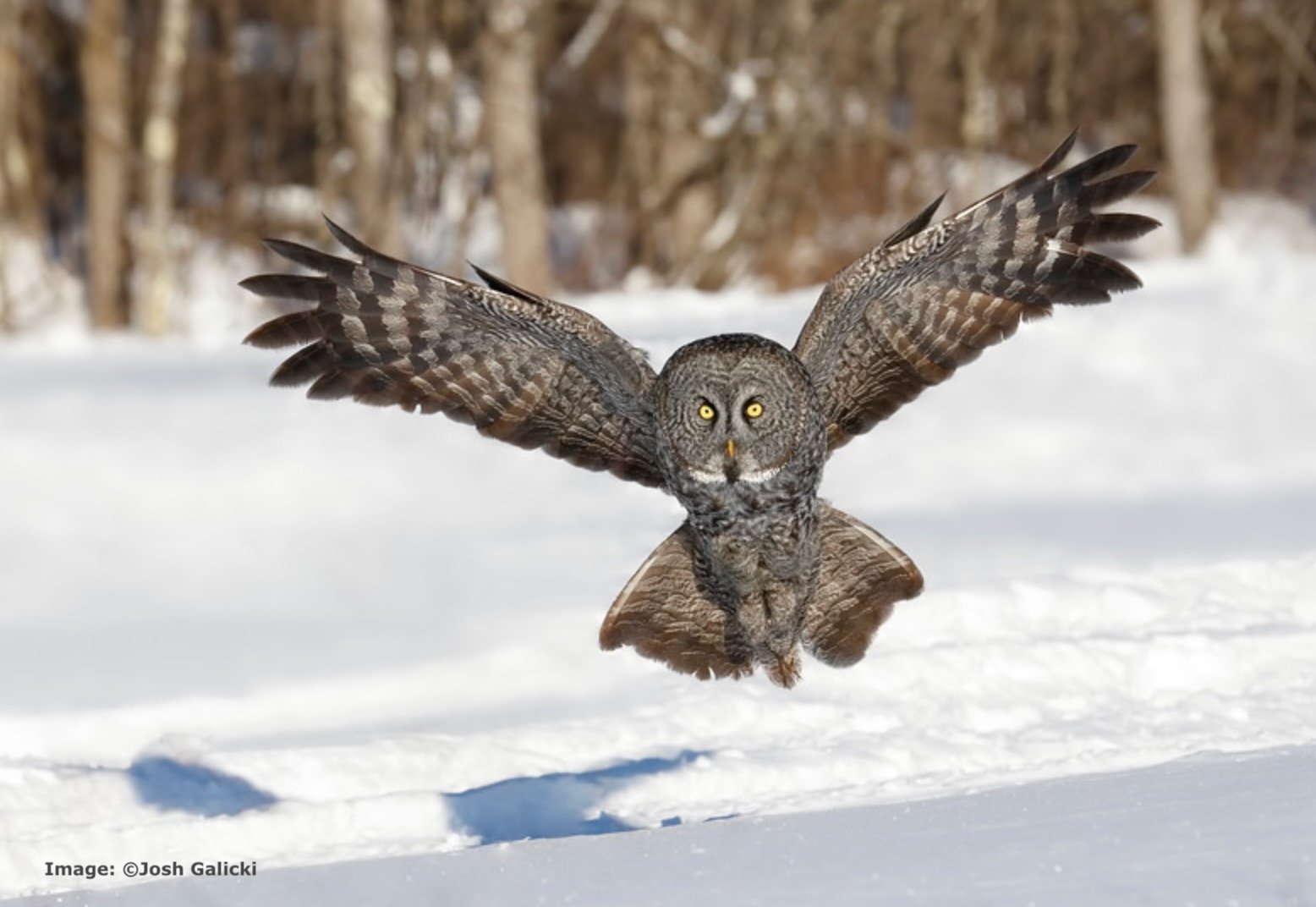
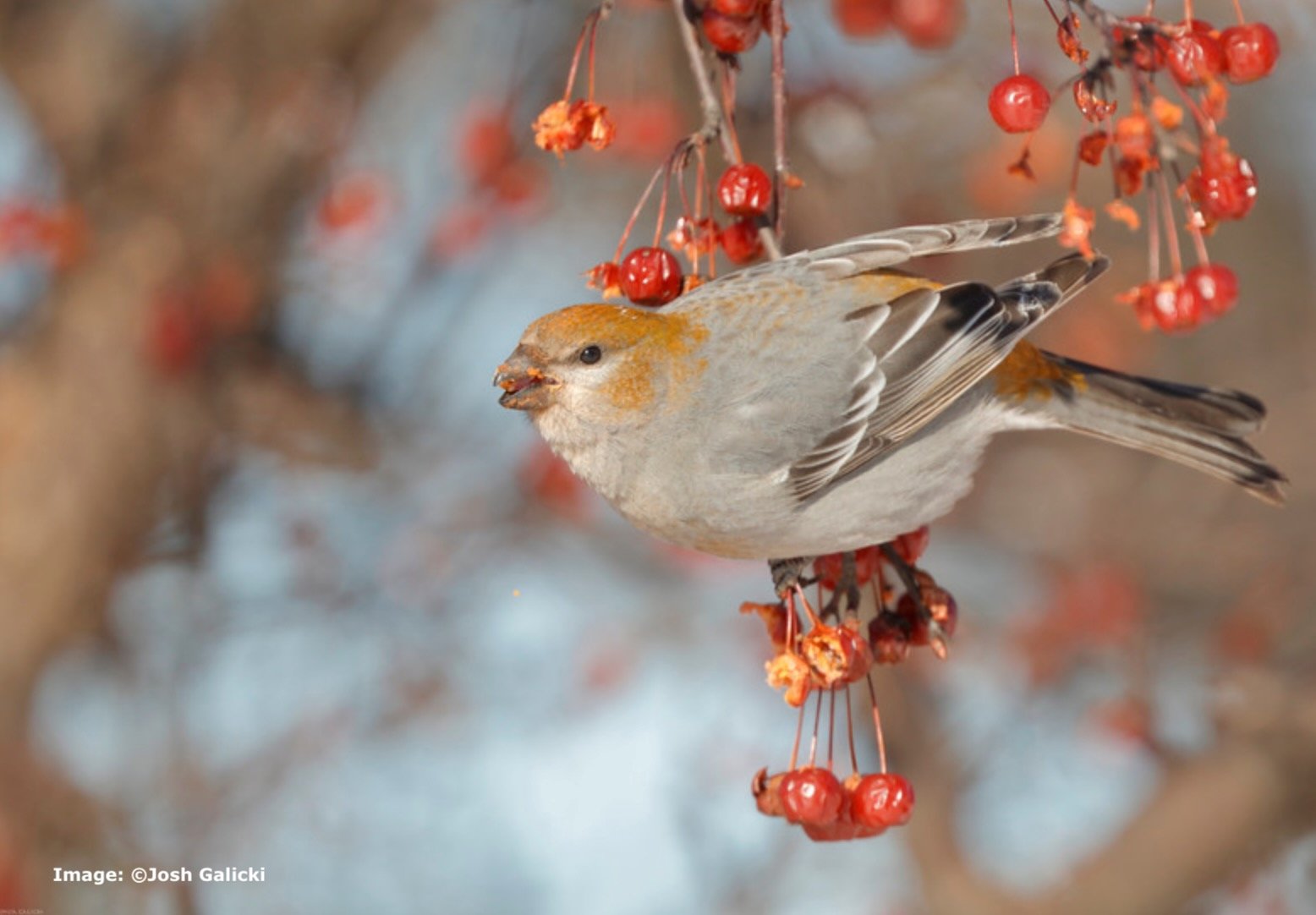
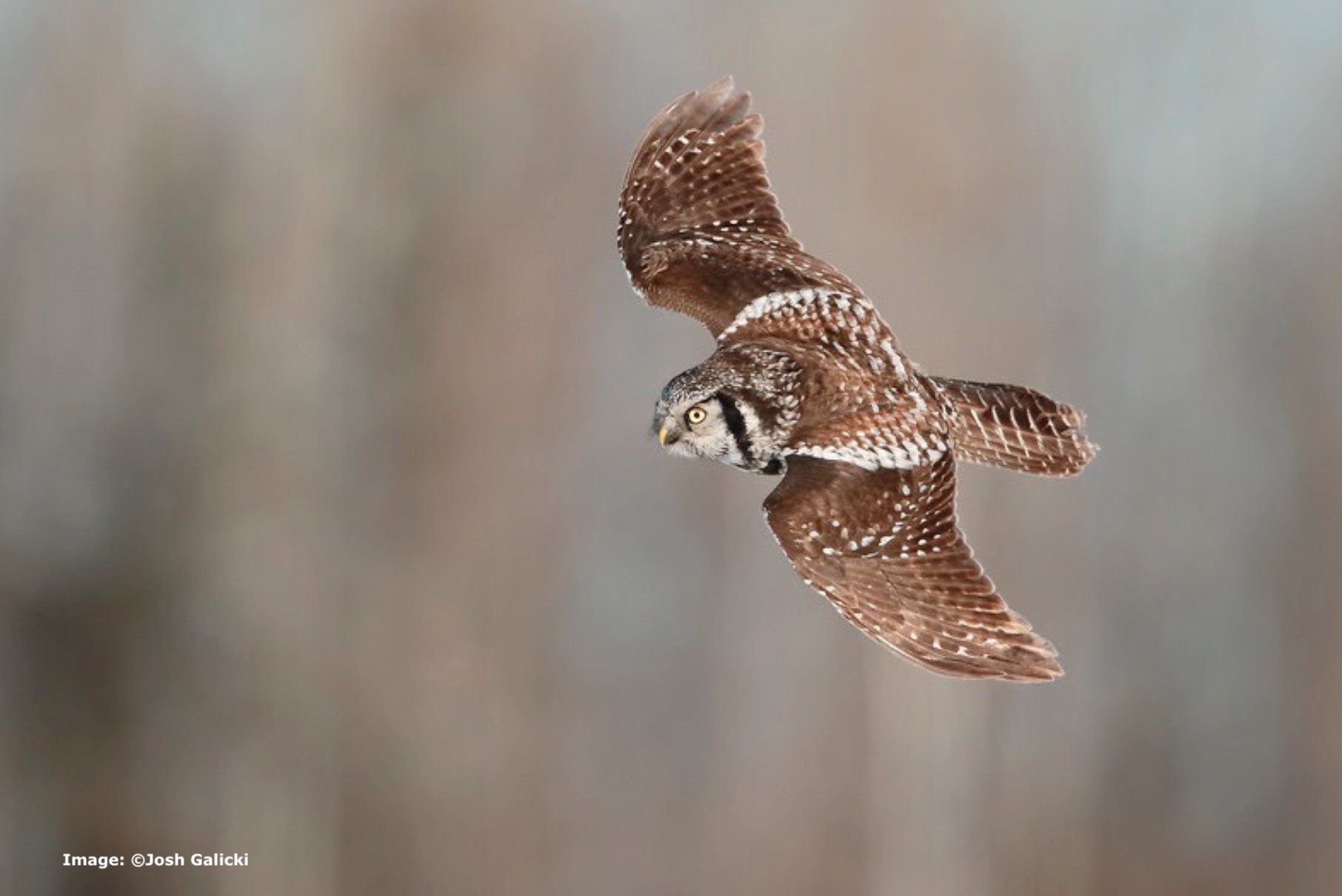
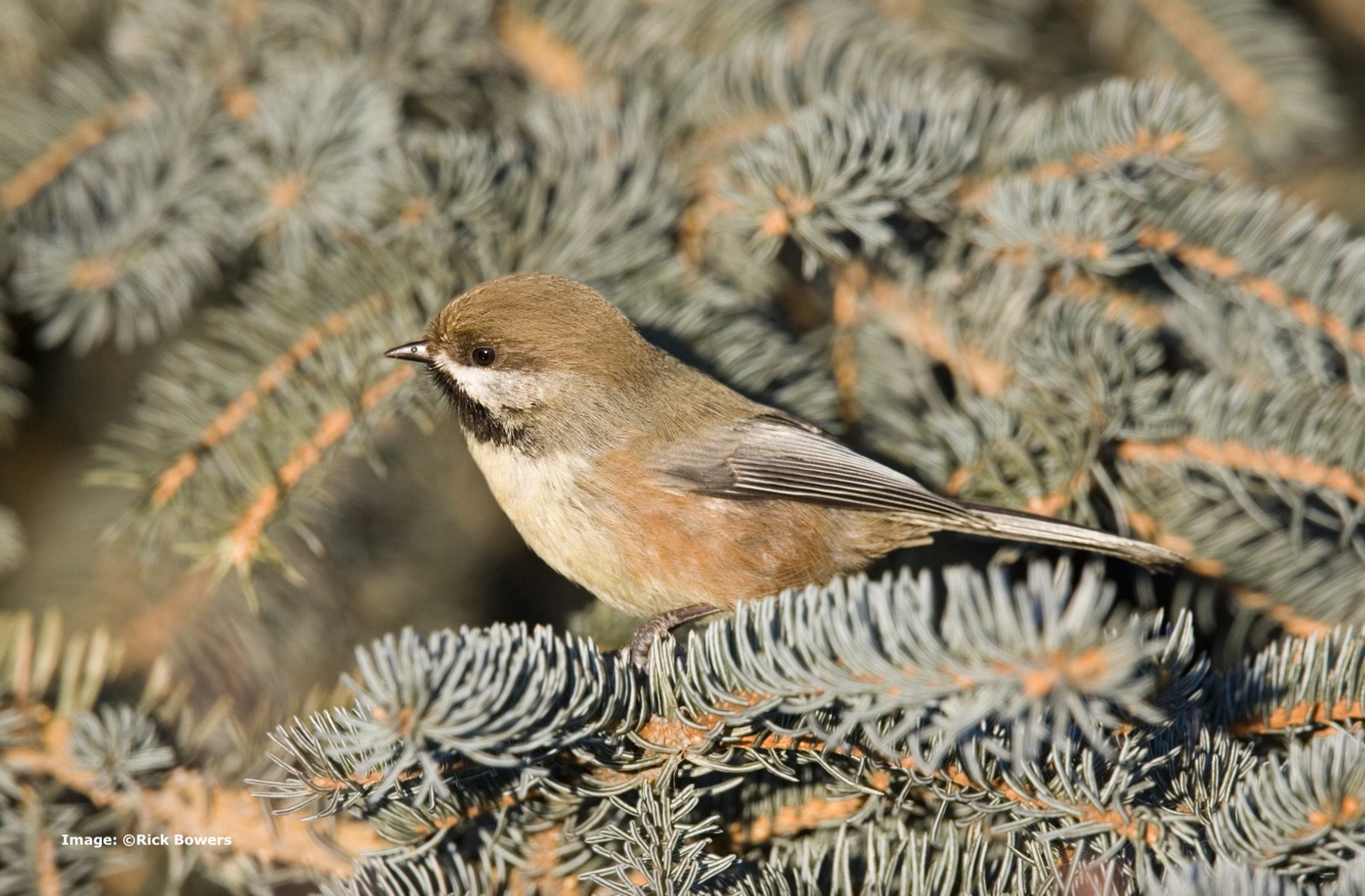
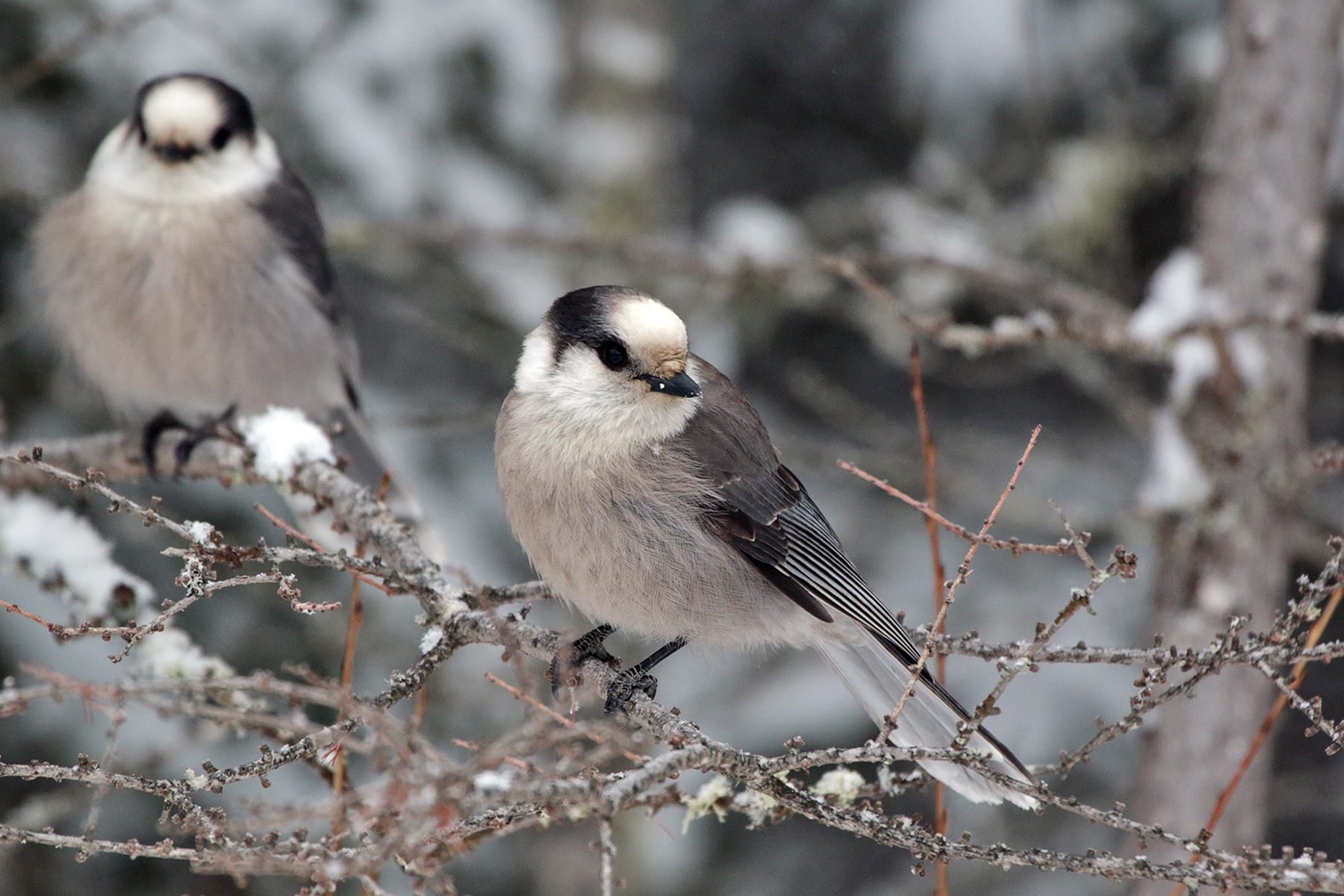
Detailed Itinerary
Detailed Itinerary
Day 1, Jan 14:
Arrive in Minneapolis - Welcome Dinner
Welcome to Minnesota! Please arrive in Minneapolis today. We will enjoy a welcome dinner together and get ready for our early start in the morning!
Dinner and Overnight in Minneapolis
Black-backed woodpecker thanks to ©NatureScape Tours. Although difficult to monitor, this disturbance sensitive bird is used by researchers as an indicator of the health of a forest. We will look for it.
Day 2,
January 15
Local Birding in Minneapolis - and Transfer to Duluth.
Today, we begin our great Owl search! Our morning is dedicated to the search for the Northern Saw-whet and Long-eared Owls as we begin our adventures across Minnesota’s snow-covered landscape. Time is set aside for local birding to look for any unusual birds or staked-out rarities before we begin our northward journey to the justifiably famous Sax-Zim Bog. We will enjoy an afternoon traveling the mythical backroads, crisscrossing the Sax-Zim Bog, searching for the thoroughly impressive Great Gray Owl.
Dinner and Overnight in Duluth, Minnesota
Day 3 - 5
January 16 - 18
Duluth, Superior, and Northeastern Minnesota’s Aitkin, Cook Lake, and St. Louis Counties
We will visit secluded boreal forests bordering the Boundary Waters Canoe Area Wilderness, searching for Spruce Grouse, Black-backed and American Three-toed Woodpeckers, Red and White-winged Crossbills, Boreal Chickadee, and the always entertaining Canada Jay.
We’ll travel Lake Superior’s north shore and marvel at the simple beauty of ice kaleidoscopes along the rocky shoreline while we scan for ducks and gulls. Long-tailed Duck, Common Goldeneye, Red-breasted, and Common Mergansers are the more expected waterfowl species, but rarities such as Harlequin Duck and Barrow’s Goldeneye have been found in recent years.
Superior, Wisconsin, offers several vantage points to scan for raptors wintering in the harbor area, and its landfill usually hosts a good variety of gulls. Raptor possibilities include Snowy Owl, Red-tailed Hawk, Peregrine Falcon, and, if lucky, Gyrfalcon.
A typical collection of winter gulls could include Herring, Glaucous, Iceland, Great Black-backed Gull, and perhaps a rarity or two.
Expansive bogs, meadows, and forests of St. Louis County’s magical Sax-Zim Bog and neighboring Aitkin County’s Tamarack peatlands are reliable places to find Great Gray and Northern Hawk Owls. If snow levels are low enough, an assortment of Rough-legged Hawks and Snow Buntings is likely. These are also the best areas for Ruffed and Sharp-tailed Grouse (sometimes displaying early on sunny days even in February!), Northern Shrike, and Black-billed Magpie.
Duluth and other cities of the Arrowhead region are wonderful birding areas in their own right. Large numbers of Mountain Ash and Flowering Crab Apple trees are a magnet for Bohemian Waxwings and rarities like Varied Thrush and Townsend’s Solitaire. Highlights from past years include finding thousands of Bohemian Waxwings feeding voraciously on Mountain Ash trees while other winters provided cooperative Mountain Bluebirds, stunning Harlequin Ducks along Superior's North Shore, an ethereal Ivory Gull, and true vagrants as King and Common Eider, Tufted Duck, Golden-crowned Sparrow, and Gray-crowned Rosy-Finch.
Long-established feeding stations buzz with activity, and Common and Hoary Redpolls, Pine and Evening Grosbeaks, and the more common winter finches are all likely to be found.
But it’s the owls that remain so highly prized by visiting birders and photographers, and in recent winters, we found (and photographed) Snowy, Great Gray, Northern Hawk, and Boreal Owls.
While numbers fluctuate from year to year, the Great Gray Owl is a permanent resident of Northeastern Minnesota, the Northern Hawk Owl is an annual visitor, and, during an owl irruption winter, anything goes.
Like the Great Gray Owl, the Boreal Owl is a permanent resident of Northern Minnesota. Unfortunately, unlike the Great Gray Owl, they are NOT to be expected during a single visit. Our best chances are to hope for an irruption year or that we find one on its day-roost. (Our leader is well connected with the region’s active birders, and the local network is always in contact when a rarity appears.)
Of course, if we have an owl irruption winter, anything goes!
Day Six, Jan. 19.
Our tour ends at about 1:00 PM in Duluth
We will have one final morning to explore the magical nooks and crannies of Sax-Zim Bog. Our birding adventure will conclude at about 1PM. We will head to the Dulith International Airport (DLH)
Note: If anyone would like to stay the night and head out in the morning, please let us know, and we will make the arrangements
What looks like an owl but behaves like a hawk? The non-migratory Northern Hawk owl is found only boreal forests. Image: ©Josh Galicki
Accommodations
Accommodations
At Destination: Wildlife, we strive to apply the principles of responsible, conservation tourism - travel that supports wildlife, habitats, and local communities. This implies a commitment to ensure your tourism dollars stay local, creating jobs and improving the livelihoods of those who live there. We use locally owned or operated accommodations, restaurants, and other providers for these reasons. This commitment ensures your travel dollars work for a local economy, and that you receive the personal touch and authentic experiences only small business can provide.
LODGING: We will stay in hotels near our birding/photography destinations, some are rather remote and not geared to luxury tourism. Our hotels are uniformly clean and comfortable with the standard hotel amenities (two bedded rooms, private bathroom facilities, hot water, phone, etc.).
Laundry Service: Laundry service may be available at the guest laundry of most of our hotels during your visit, barring unforeseen circumstances such as mechanical or electrical failure. However, their hours of operation and our schedule may not allow us to take advantage of laundry service. Items that can be washed in your room’s sink and hung to dry overnight are always a good idea.
WiFi and Internet Service: Some areas are remote and there may not be WiFi or internet access all or part of the day in the field or at some lodging.
Tour Information
Tour Information
The boreal forests, bogs and grasslands of Minnesota are magnificently beautiful in winter, and filled with wildlife in the air and ground, truly a Winter Wonderland. Image: ©Kim Risen
Dates
January 14 - 19, 2026
Start and End Point
The tour starts in Minneapolis and ends in Duluth, Minnesota
Reserve Your Spot
►50% deposit reserves your spot
►Please call Roberta at 908-656-4016 or contact us here
►Final 50% is due September 15th, 2025
This small, handsome fellow is known as the Boreal owl in Minnesota, but they are called Tengmalm’s owl after Swedish naturalist, Peter Gustaf Tengmalm. Image: ©Cindy and Kim Risen
Travel Insurance
For all Destination: Wildlife tours, all guests must have a minimum level of travel insurance coverage for medical emergencies. We highly recommend comprehensive travel protection for your tour. If you decide against Travel insurance, you must sign a waiver of release before departure.
Important note: Most travel insurance does not cover preexisting conditions unless purchased within 14 days (of the initial deposit and 7 days for some carriers). We highly recommend purchasing your travel insurance immediately after making a deposit.
Please contact us if you need assistance.
Getting There and Back
Arrival: We will arrive on January 14th for a more relaxed start in case of delays or inclement weather. We will enjoy our welcome dinner together.
Early Arrival: If you would like to arrive a day or so early, please let us know, we can make the hotel arrangements for you.
We will start out after an early breakfast on January 15th. The group will not be able to wait for late Guests. If a participant is delayed and the group moves on, it will be the sole responsibility of the Guest to catch up.
Departure: Our birding tour ends on January 19. After a final morning of birding, we will be brought to our hotel at the Duluth International Airport. There we will have a final dinner together. Most guests will leave on the 20th. If you plan to leave on the evening of the 19th, please let us know.
Need help with transportation or hotel rooms? Just ask.
Group Size
Limited to 8 Guests. The tour's group size is limited to 8 guests plus a tour leader and local expert guide. Our small group allows for more interaction between guests and our guide, flexibility in our accommodation and ground travel choices, and can provide for a richer personal experience.
Price
$4983.00 (USD) pp, double occupancy, excluding flights.
► Price does not include round-trip airfare or other transportation to Minneapolis.
► There is a single-room supplement of $375.00.
► A $500 donation to Project SNOWstorm is included in the tour price. This donation is tax-deductible for US residents.
Included:
► Tour Price Includes: Accommodations, services of a trip leader and professional guide, entrance into all reserves and parks, private transportation during the tour, all meals from dinner on Day 1 through dinner on Day 6, snacks during the excursions, airport transfers on the first and final days, and all internal transfers.
► Donation: A $500 donation to Project SNOWstorm is included in the price of the tour, and this donation is tax-deductible for US residents.
Not Included:
► Travel to and from Minnesota, beverages, gratuities, passport and visa fees if required, airline baggage fees, travel insurance protection, and medical evacuation insurance, items of a personal nature (phone calls, laundry, and internet, etc.).
Cancellation Policy
Please see here for our cancellation policy
Need to Know
Need to Know
Physical Requirements:
Moderate. This is generally a moderately active trip
Birding and photography during the region's winter season consist of early starts with predawn breakfasts at our hotel. Luckily, we will be enough north that the sun will not rise until about 7:30 AM during our tour! ]
A few mornings may have predawn drives of up to an hour for our first birding areas so that we will set our alarms accordingly.
Spruce Grouse Image: Thanks to ©NatureScape
Please note: there WILL be situations where the leader(s) will ask the group to walk for birding or to a photography site. You should be in reasonable physical condition and able to walk up to a half mile at a time, at a birding pace, over flat terrain.
It will be cold. As each day may have a bitter cold, fog, snow, and an oft-present wind, rain —or any combination of these—much of our birding is done from the comfort of our vehicles. The snow-covered terrain makes walking off roadways difficult. Consequently, most out-of-vehicle birding will be along plowed roads, walkable paths, or packed trails, almost always near our vehicles. Any walks through the snow are short and always at your option to participate. As you might expect, we will spend much more time in the vehicle than on most tours.
Our travel will be in a van or SUV with window seats for everyone! This ensures that there are no problems with space or discomfort during the ride for the duration of the tour.
The roads we travel vary significantly in condition. From paved and 'highway-like' to dirt/rocky tracks through the northern boreal forest, that will seem more like bumps atop bumps when traveling in remote inland locations. Thankfully, these latter drives are not long and shouldn't pose a problem—to our vehicles or spines! Access roads to some forest areas can change significantly from month to month and year to year, depending upon logging activity, but we'll be prepared for almost anything.
Health
As always, when traveling, be sure to bring a sufficient supply of prescription or over-the-counter medication to safely see you through your tour travels.
Pack all medication in your carry-on baggage in their original containers. Airline baggage restrictions often change with little or no warning, so please check with your airline in the weeks before departure.
Standard travel precautions recommend that you stay up to date with your MMR and Tetanus shots, and we encourage all travelers to receive vaccinations as recommended by the CDC.
Your enjoyment on the trip depends heavily on being prepared for the cold and wind. Warm, waterproof clothing and sturdy waterproof boots are essential gear. By dressing appropriately, you'll find the northern winter surprisingly manageable. Please review our recommended packing list. A wealth of general health information for travelers can be found at the US Centers for Disease Control and Prevention (CDC) in Atlanta, GA., the CDC website at: www.cdc.gov/travel
Climate:
Northern Hawk Owl. Image Thanks to ©NatureScape Tours
Minnesota is cold. The high temperature in Duluth and the surrounding areas averages 20°, and the low averages about 5°
Expect cold and snow, windy and possibly wet conditions in some areas. Please see the packing list below.
TIME:
Our tour route lies entirely within the Central Time Zone.
Meals
Breakfast will be at the hotel. Lunch may be boxed or, when available, at mom-and-pop cafes or sandwich shops. Most dietary restrictions (plant-based diets, gluten-free, etc.) can be accommodated at the hotels and lodges, however, we will be spending time in towns that may not offer the food choices of larger cities. We recommend packing personal snacks if you have dietary restrictions or allergies. Please inform us of any dietary requirements due to medical or personal restrictions.
Because the sun sets quite early this far north—generally around 5:00 PM—our birding days are not long. Dinner is by far our most relaxing meal of the day, usually at a restaurant close to our hotel, often beginning with a social/cocktail hour as we review the day's adventures and photographs and complete a checklist of our sightings.
Responsible Photography:
Photographers are welcome but are expected to follow responsible birding and wildlife photography etiquette and guidelines.
We DO NOT chase, flush, or bait birds. Period
Bring the longest lens you have, or consider renting one if you don’t have one for the trip. A startled bird uses up the precious energy necessary for survival in these harsh conditions. We will stay well back to avoid disturbing them.
Binoculars are a must, and for good photography, you will need a long lens.
Additionally, birds do not pay attention to property lines, but humans must. Regardless of the excitement of finding a particular species, respect for the property owner is of paramount concern. Different property owners have different tolerances, and we will respect each individual’s wishes.
And please remember that this is a bird “watching” tour first and foremost.
The scenery, activities, culture, people, and birds we visit & witness will be highly memorable. Landscape, people, and memory shots will be relatively simple to take, serious bird photography is a different matter. You will bring back unforgettable images in your heart - and if the conditions are correct, and you have sufficient lenses, we hope that you bring home a few on “film,” too.
Bring your equipment with you, as it may be difficult, if not impossible, to find your particular brand once we arrive.
We always recommend precautionary measures to protect your equipment; moisture and dust-proof bags are a good idea. We do spend time watching feeders and food sources that can offer exceptional bird photography. Please let us know if you have any questions about photographing birds in winter. Our tour leader will be happy to help you.
SMOKING:
Smoking is prohibited while in vehicles or close quarters with the group, such as during mealtime, while doing the checklist, or at group meetings. If you share a room with a nonsmoker, there is no smoking in the room. While in the field, we ask that you smoke away from the group, preferably downwind.
Packing and Notes
Packing List and Notes from our Guide, Kim Risen
The weather in January can be VERY cold. Expect deep snow and frozen conditions. While much of our birding will be from a heated vehicle, the best weapon in your arsenal against cold is dressing in layers. It's your most advantageous defense against unpredictable weather.
► OUTER LAYERS of clothing should—at a minimum—fit loosely over your various inner layers. The air space between your layers provides warming insulation, so the tighter your clothing fits, the faster you'll get cold. You'll never regret erring on the large side with your winter clothing. Cold-weather gear is ESSENTIAL and should include
1. Thermal underwear (both tops and bottoms), long-sleeved shirt (I like a turtleneck),
2. Fleece, sweater, or sweatshirt - a fleece is best.
3. Heavy 'winter' coat or jacket. Rain and windproofing are optimal.
4. Snow pants or wool pants. Lacking either, bring pants constructed of the heaviest material you have.
Note: Jeans easily become wet/frozen and are slow to dry; they are not your best choice.
Notes: I've found that medium-weight wool or similar synthetics like polar fleece for shirts and sweaters work best. If you chill easily, add another layer or increase the weight of your outermost layer. Wool is a good idea if you can wear it because it retains its insulating properties even when wet; it should be your material of choice for caps, mittens, socks, and pants. Heavy wool or synthetic snow pants over light sweatpants or thermal underwear work best.
► EXTREMITIES — hands/fingers, head, facial features, and feet/toes—are particularly vulnerable to cold temps and wind. To be most prepared, bring:
5. Wear a warm cap and scarf (I use a neck gaiter) to cover your ears, head, and neck.
6. Balaclava: Anyone particularly sensitive to cold might consider wearing a balaclava. This formfitting hood fits over the head and face, with cutouts for the eyes and a slitted covering for the nose.
7. Hands: Mittens work better than gloves to keep hands warm. However, they do restrict hand use.
8. Socks: Heavy wool (or synthetic equivalent) socks.
9. Footwear: Insulated, waterproof footwear will help keep you comfortable in the field.
We strongly recommend bringing insulated boots; those with felt liners work particularly well (Sorel and LaCrosse brands are my favorites), as opposed to leather hiking or work boots.
Notes: Boot Fit: It's essential that your boots fit loose enough to accommodate your feet while wearing heavy socks—wool is preferred. I cannot stress enough how important it is that your feet do NOT fit tightly within your boots. While I find that 'Gore-tex' hiking boots work well for me, please keep in mind that I live in Minnesota and am used to cold, wet, and snow! I promise they will NOT keep YOUR feet warm under typical winter conditions.
►THINGS I DON’T LEAVE HOME WITHOUT
10. Emergency Kit: Cipro and Immodium for "traveler's stomach," Band-Aids, hydrocortisone cream, and anti-fungal ointment.
11. Cash. My preference is to carry a small amount of cash for tips or personal purchases. I keep my credit cards and identification on my person at ALL times. ATM machines should be available.
12. Sunscreen is critical if it is sunny even in very cold weather. Bring it.
13. Extra batteries for anything that uses them.
14. Sunglasses, an extra pair of eyeglasses, and anti-fogging cloth/spray.
►OTHER STUFF I travel with:
15. Binocular rain guard,
16. Sink stopper
17. Various-sized waterproof bags (to keep books and TP dry),
18. Bandanna
19. Notebook and pencil
20. Big waterproof bag for dirty boots
21. Ear plugs, and ventilated toothbrush holder
Note: Do not plan on buying supplies such as sunscreen, memory media, batteries, etc. Bring plenty. Keep in mind that this region is a remote country. Our itinerary is subject to change based on the idiosyncratic nature of birds, weather, and transportation. Expect things to be different, and enjoy the differences!
Equipment - Don’t forget your:
✓ Binoculars!
✓ A daypack is handy for carrying your books, sunscreen, and smaller items—put your name on it.
✓ An alarm clock is essential—you don't want to miss those precious morning birding hours!
✓ Camera
✓ Lenses - the longest you have
✓ Memory Cards and Batteries
* Scope The Guide will have a superb spotting scope for the group's use, but if you have one and wish to use it, please feel free to bring it along.
Experienced traveler's tip: It's always a good idea to pack your binoculars, your camera, a change of clothing, toiletry items, prescription medications, and travel documents in your carry-on luggage in the event your checked baggage is delayed or lost.
LUGGAGE:
✓ Bring what you need but please consider the usefulness of each item. One bag plus your carry-on is optimal.
✓ Soft-sided luggage is a necessity as it is more easily handled or loaded into vans.
✓ Weight: Please do not bring excessively heavy bags. If you cannot lift your bag, consider two lighter bags instead.
✓ Tag it! Remember to attach an identification tag to the outside of your bags. We recommend inserting a similar tag inside each piece of luggage.
Making a Difference
How Your Trip Makes A Difference
This Snowy Owl seems unbothered by the frozen conditions of its Arctic home. We visitors, however, best make good use of the tour packing list! Image: Thanks to Jean Hall and Project SNOWstorm.
This tour directly supports:
Project SNOWstorm
About Project SNOWStorm in their own words:
“Project SNOWstorm was launched in 2013 and is now one of the world's largest collaborative research projects focusing on Snowy Owls. It is staffed by a largely volunteer team of scientists, banders, and wildlife veterinarians. We are funded entirely by tax-deductible donations from the public.”
Scott Weidensaul is co-founder of Project SNOWstorm, This is from his letter welcoming supporters to the new 2023-2024 season of Snowy Owl research:
This will be Project SNOWstorm’s 11th season of snowy owl research as we wait for previously transmittered birds to come back south in the weeks ahead and look toward tracking new owls this winter, each of which will add to our rapidly growing understanding of this species’ winter ecology. But there’s also been a lot of work going on in the so-called off-season, too, and we’re anxious to share more about that with you in the weeks ahead. In the meantime, there’s a summary here of what we’ve been up to.
As has been the case from its start in December 2013, SNOWstorm remains funded entirely by donations from the public (tax-deductible for U.S. taxpayers; apologies to our many Canadian friends). And as has also been the case from the beginning, no one on the SNOWstorm team takes any kind of salary or stipend — we’re all volunteers here, so all the funds we raise go directly into the field or the lab, covering the costs of transmitters, GSM data fees or satellite time for the data transmission, toxicology and other lab analysis, and covering basic expenses like fuel, food and lodging for our collaborators when they’re in the field trapping for us. Read more
Why Project SNOWstorm?
“Project SNOWstorm's tracking work represents the largest and most diverse set of winter movement data for snowy owls anywhere in the world, and we're drilling down into it to see what it reveals about these Arctic migrants, the habitats they use, and how best to protect and conserve them.
We continue to publish a stream of peer-reviewed scientific articles based on our research, so our findings inform the wider conservation of snowy owls, in such prestigious international journals as Nature, Ornithology, Oecologia and Ibis, on subjects ranging from the winter survival of immature snowy owls; factors associated with the return of translocated owls to airports; whether snowy owls migrating north in spring use stopover periods to sample potential breeding sites; and the influence of landscape cover versus social dominance on snowy owl movement patterns.
We provided significant support for the post-doctoral work of Dr. Rebecca McCabe as she, with our colleagues in the International Snowy Owl Working Group, completed a global status assessment of snowy owl populations worldwide -- the first time such an effort has been made, and a critical step in determining conservation action for this species. This assessment is currently in peer review pending publication.” read more
Great Grey Owl studies the evenings “menu” hidden deep in Minnesota’s boreal forest. Join us! Image: Thanks to ©NatureScape Tours

